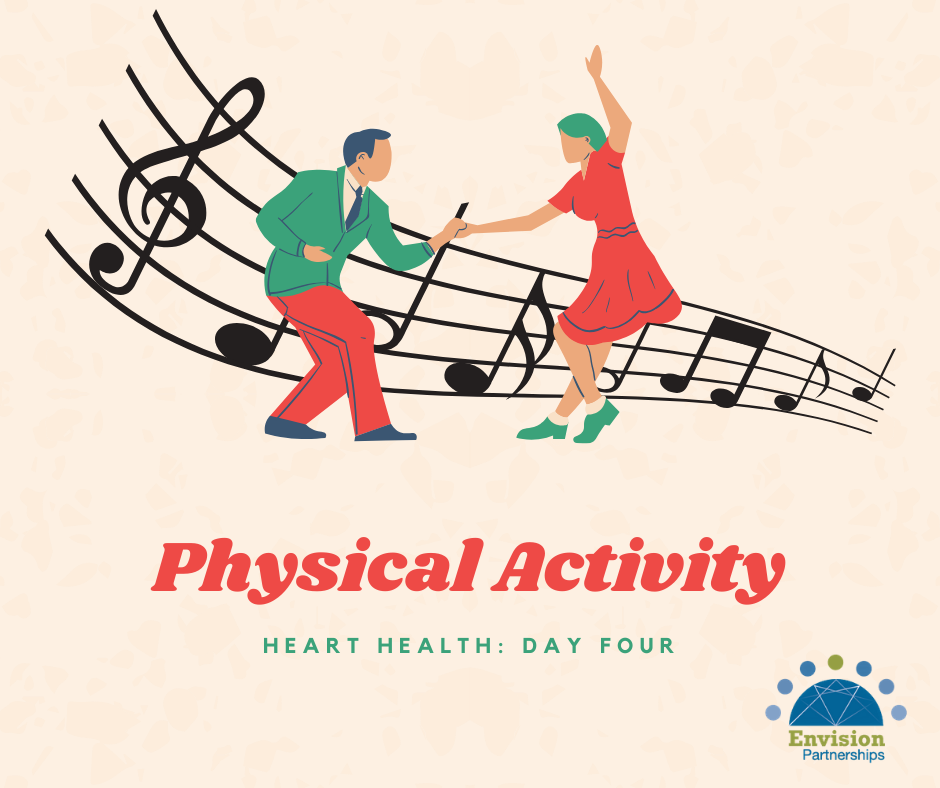
Day Four: Exercise
Along with diet, exercise plays a major role in good heart health. Unfortunately, only 1 in 5 adults and teens get enough exercise to maintain good health. How much exercise exactly? Recommendations from the Physical Activity Guidelines for Americans, 2nd edition, published by the U.S. Department of Health and Human Services, Office of Disease Prevention and Health Promotion are provided below:
-150 minutes of moderate-intensity aerobic activity or 75 minutes of vigorous-intensity aerobic activity per week (spread throughout the week).
-Moderate to high-intensity strength training (weights or resistance) on at least two days per week.
-Spend less time sitting; even light-intensity activities can be beneficial.
-Being active for 300 minutes per week can result in even more benefits (5 hours spread throughout the week).
-When increasing the intensity or duration of physical activities and exercise, do so gradually.
Examples of Moderate-Intensity Activities: a few examples from the CDC include brisk walking, hiking, cycling at 5-9mph, aerobic dancing, yoga, weight training, gardening, etc. The AHA describes aerobic/moderate-intensity activity: "your heart will beat faster and you’ll breathe harder than normal, but you’ll still be able to talk. Think of it as a medium or moderate amount of effort."
Examples of High-Intensity Activities: a few examples from the CDC include jogging or running, mountain/rock climbing, cycling more than 10mph, jumping jacks, karate, swimming laps, heavy yardwork, etc. The AHA describes vigorous/high-intensity activity: "Vigorous intensity activities will push your body a little further. They will require a higher amount of effort. You’ll probably get warm and begin to sweat. You won’t be able to talk much without getting out of breath."
What Exercise is Right for You?
Everyone has their preference when it comes to exercise. Some people would rather run than lift weights, and others would choose a strength session over cardio any day. Which form is exercise is the best for heart health? An article from Johns Hopkins suggests a mix of three kinds of exercise: aerobic exercise, resistance/strength training, and stretching, flexibility, and balance. Here's the benefits of each type and how often people should do them:
-Aerobic: improves circulation (leading to lower blood pressure and heart rate), helps cardio output, reduces risk of type 2 diabetes, and in those who already have type 2 diabetes it can help control blood glucose. Ideally done for 30 minutes per day, 5 days a week.
-Resistance: in those with greater amounts of body fat, it can help reduce fat and increase lean muscle mass. Research shows a mix of aerobic exercise and resistance work can help raise the good cholesterol (HDL) and lower the bad cholesterol (LDL). Ideally done two consecutive days per week, according to the American College of Sports Medicine.
-Stretching/Flexibility/Balance: while these don't directly contribute to heart health, they help with musculoskeletal health. Good musculoskeletal health allows people to be flexible and without joint pain, cramping, etc. It's also essential to have good flexibility when participating in resistance training and aerobic exercise. Ideally done every day both before and after other exercise.



